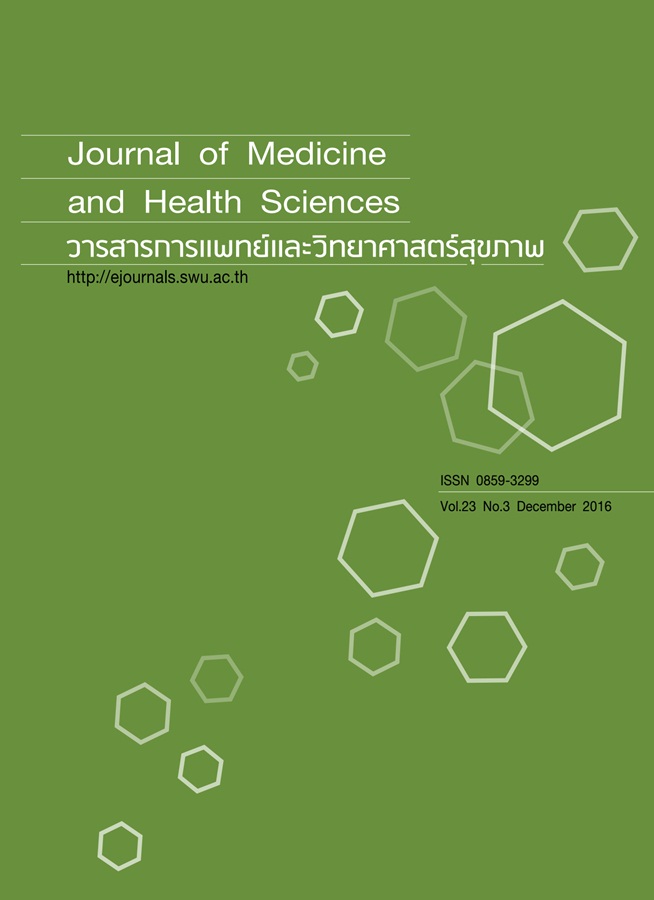Botolinum toxins: their structure, properties, and genetics สารพิษโบทูลินั่ม: โครงสร้าง คุณสมบัติ และ พันธุศาสตร์
Keywords:
Clostridium botulinum, botulism, botulinum toxin, BoNT คลอทริเดียมโบทูลินั่ม โบทูลิซึ่ม สารพิษโบทูลินั่มAbstract
Abstract
Clostridium botulinum is Gram positive, spore-forming anaerobic bacteria, which can produce botulinum neurotoxins (BoNTs). The toxins block the release of neurotransmitter, acetylcholine, at peripheral cholinergic nerve terminal and cause flaccid paralysis of muscle in human and animals, a condition known as botulism. BoNTs are classified into seven different serotypes (designated as BoNT/A-BoNT/G), in which serotype A, B, E, and F cause botulism in human. BoNTs are comprised of one domain of light chain (L-chain) at N-terminus and two domains of heavy chains (H-chain) at C-terminus. The function of L-chain is to cleave SNARE (soluble N-ethylmaleimide-sensitive factor attachment protein receptors) proteins that involve in the exocytosis of neurotransmitter whereas H-chain is responsible for binding of toxin with nerve terminal and translocating of L-chain into cytosol from synaptic vesicle. The BoNTs are usually produced as complexes called progenitor toxin complex (PTC). They bind together with neurotoxin-associated proteins (NAPs), which are haemagglutinin (HA) and non-toxin non-haemagglutinin (NTNH). The NAPs can protect BoNTs from gastrointestinal environment and facilitate the absorption and translocation of neurotoxin into main circulation. The genes encoding BoNTs and NAPs are arranged as gene cluster, which are organized in two operons: ha and orfX operons. Mostly, they are located on the chromosome, large plasmid, or bacteriophage at the specific location and can be transferred horizontally to other clostridia strains.
บทคัดย่อ
Clostridium botulinum เป็นแบคทีเรียแกรมบวกที่ไม่ต้องการออกซิเจน สามารถสร้างสปอร์และผลิตสารพิษโบทูลินั่ม (Botulinum neurotoxin หรือ BoNT) ที่มีผลต่อระบบประสาท ทำให้เกิดโรคโบทูลิซึ่ม (Botulism) โดยสารพิษจะไปยับยั้งการหลั่งสารสื่อประสาทชนิด อะเซติลโคลีน (acetylcholine) ที่ปลายประสาทของระบบประสาทรอบนอก ทำให้กล้ามเนื้อเกิดการอ่อนแรง สารพิษโบทูลินั่มสามารถแบ่งเป็น 7 ซีโรไทป์ ได้แก่ ซีโรไทป์ A – G (serotype A-G) และซีโรไทป์ที่ก่อโรคในคนได้แก่ ซีโรไทป์ A, B, E และ F โครงสร้างของสารพิษโบทูลินั่มประกอบด้วย 3 ส่วน โดยส่วนแรกคือ สายเบา (L-chain) ซึ่งอยู่ทางด้านปลาย N ของสายโปรตีน มีหน้าที่ในการตัดโปรตีน SNARE (soluble N-ethylmaleimide-sensitive factor attachment protein receptor) ซึ่งเป็นโปรตีนที่เกี่ยวข้องในกระบวนการหลั่งสารสื่อประสาท และอีกสองส่วน อยู่ที่สายหนัก (H-chain) ซึ่งอยู่ทางด้านปลาย C ทำหน้าที่ในการจับกับโมเลกุลบริเวณผิวของปลายเซลล์ประสาท และ ช่วยในการส่งผ่านสายเบา (L-chain) เพื่อไปออกฤทธิ์ในไซโทพลาสซึมของเซลล์ประสาท โดยปกติแล้วสารพิษโบทูลินั่มถูกผลิตขึ้นในรูปของสารประกอบเชิงซ้อนที่เรียกว่า progenitor toxin complex (PTC) ซึ่งจะไปจับกับกลุ่มโปรตีนที่เรียกว่า neurotoxin-associated protein (NAPs) ซึ่งก็คือโปรตีน haemagglutinin (HA) และ กลุ่มโปรตีน non- haemagglutinin (NTNH) กลุ่มโปรตีนนี้เกี่ยวข้องกับการปกป้องBoNTsจากสภาวะกรดในระบบทางเดินอาหาร และ ช่วยในการดูดซึมBoNTsเข้าสู่ระบบหมุนเวียนผ่านทางเซลล์เยื่อบุลำไส้ ยีนที่สร้าง BoNT และNAPs จะอยู่ร่วมกันเป็นกลุ่ม แบ่งได้เป็น กลุ่มยีน ha (ha operon) และกลุ่มยีน orfX (orfX operon) ซึ่งกลุ่มเหล่านี้สามารถพบได้บนโครโมโซม พลาสมิดขนาดใหญ่ หรือ แบคเทอริโอฟาจ นอกจากนี้ กลุ่มของยีนนี้สามารถเคลื่อนย้ายส่งผ่านยีนในแนวราบไปยังแบคทีเรียClostridium สายพันธุ์อื่นได้



